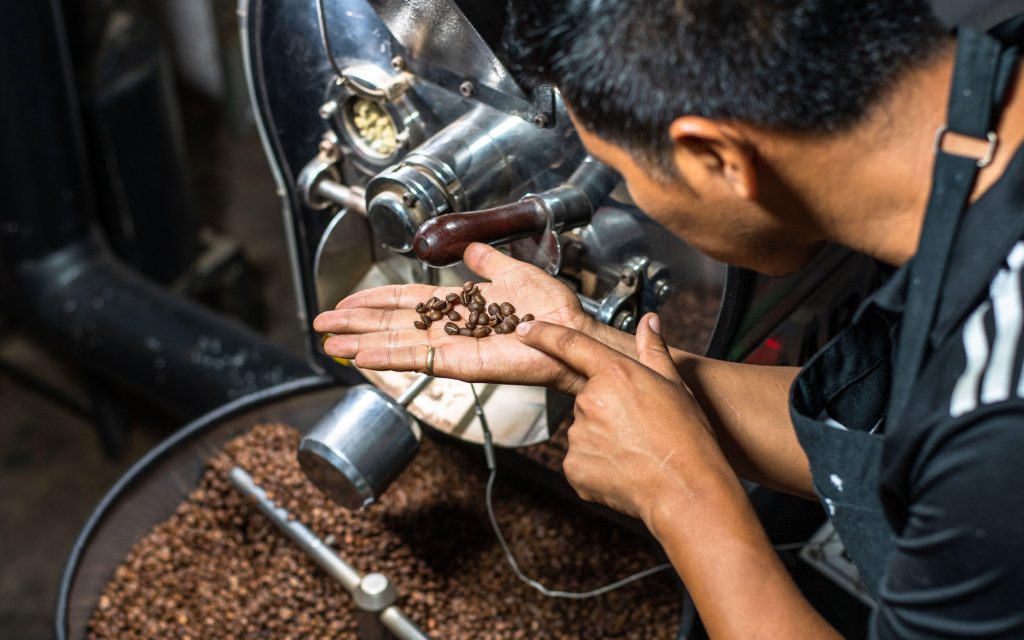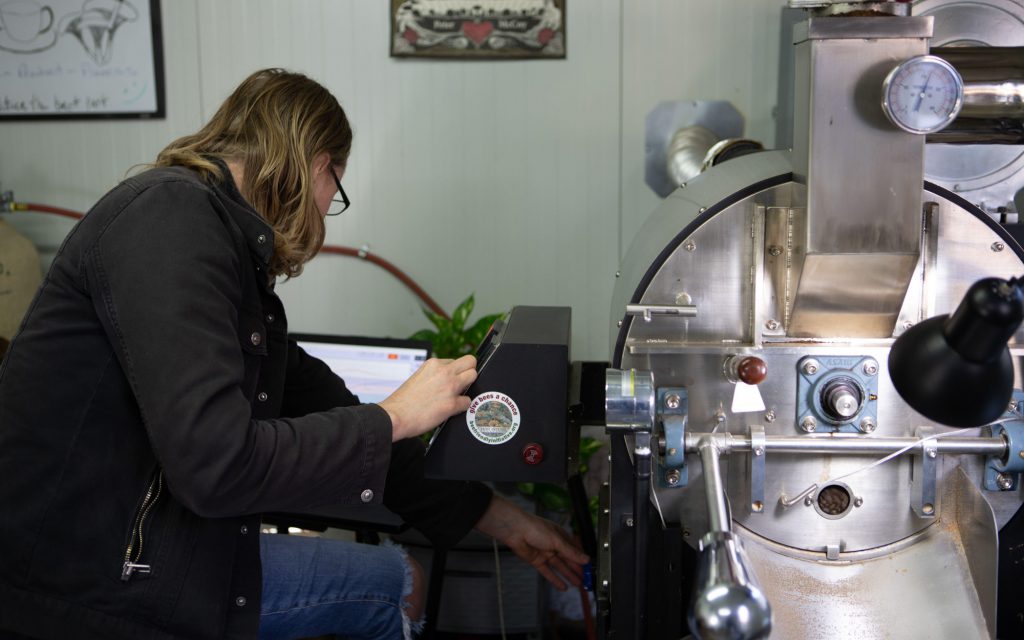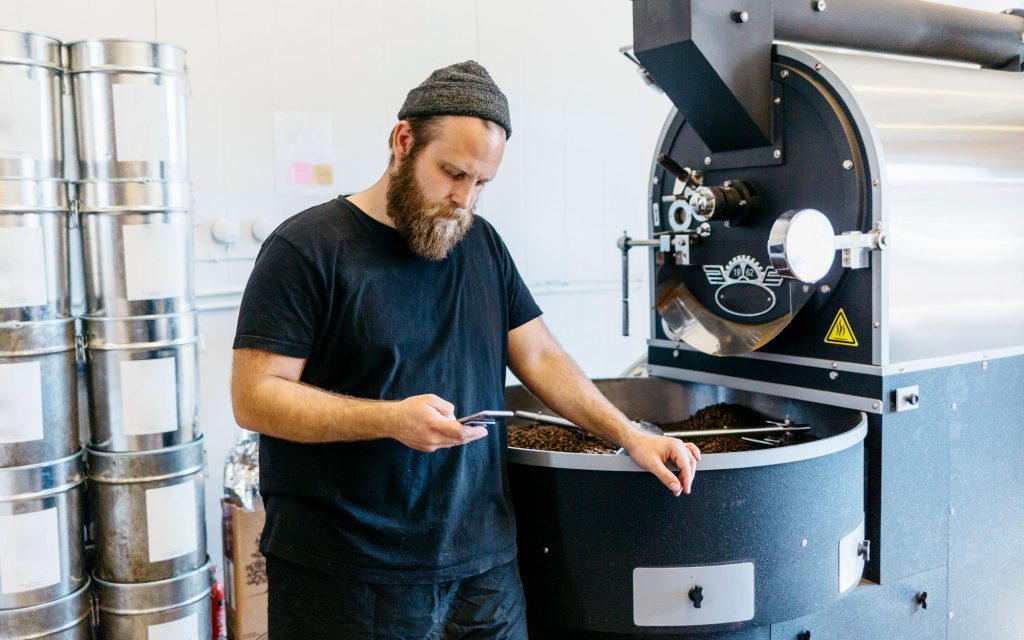A breakdown: Implementing software at your coffee roastery
In recent years, brands across the coffee sector have become increasingly reliant on technology and software.
For coffee roasters, software is mainly aimed at two things: automating parts of the roasting process and giving them more control over a wider range of data points. In essence, this equips them to better optimise workflow, streamline operations, and improve quality control.
But how straightforward is it for roasters to implement new software into their operations, and what are the factors they need to consider when doing so?
To find out, I spoke to two coffee professionals. Read on to learn more about what they had to say.
You may also like our article exploring AI in coffee roasting.

Automation across the board
Over the past few years, it has become increasingly common to use software and data collection systems in roasteries.
While implementing software can help roasters automate production roasts and spend more time on other areas of their business, data collection allows them to analyse and manage a wider range of variables which they can use to manage their roast profiles.
However, this hasn’t always been the case. Prior to this shift towards more automation, many roasters had to account for people closely managing each batch.
As far as data is concerned, we now have greater access to a wider range of variables. For example, head roasters have traditionally had to carefully evaluate the characteristics of green coffee to determine the optimal roasting parameters, such as when first crack should occur or how long the total roast time should be.
Throughout the roasting process, roasters also had to keep a close eye on a number of variables themselves. This has historically included changes to bean colour and aroma, temperature fluctuations, and listening for the audible cues of first and second crack.
These are important variables that roasters need to account for when developing roast profiles, so in order to maintain consistency in their roast profiles, they need to collect data. With limited data collection software available, roasters would often keep handwritten notebooks.
However, with automation becoming increasingly prominent, more and more coffee professionals are choosing to implement new technologies and software across their roasteries


What software should you use to manage your roastery?
Today, there are many different types of software available for roasteries, including programmes which monitor and guide roast profiles, as well as those which predict when first crack will occur.
However, deciding which specific piece of software to use will depend on a roaster’s needs. Larger roasters will have different technical requirements than smaller roasters, for instance, and specialty coffee roasters will likely require software more focused on quality control than commercial brands which are more renowned for their output.
Inventory management
Daniel Mendoza is the North American Sales Manager at Cropster, a roasting software company.
He tells me that inventory management systems are generally the first thing he recommends to roasters.
“Some roasters record all their data on paper, which can mean that their inventories are less organised,” he says. “So one of the first steps towards using more data collection systems for these roasters is inventory software.”
Moreover, many platforms designed to manage coffee roasteries have an inventory management function for tracking green and roasted coffee stock levels. Not only does this help to preserve coffee freshness, it also allows roasters to gain a better understanding of which coffees are more or less popular with customers.
Daniel explains that most roasting software suites collect a range of data points. These include sample roast profiles, physical analysis of green and roasted beans, and optimal roast profiles, which help roasters remain informed when tracking stock levels or looking for new green coffee.
“When a roaster buys coffee, [the software can store all the relevant data points] for as long as necessary,” he says. “So instead of relying on paperwork or emails, all the information is now stored in one place.”
Time between roasting batches of coffee
Another area where software can benefit roasters is time spent between roasts, or “Between Batch Protocol” (BBP). This refers to all of the actions which take place between the end of a batch and the beginning of a new one.
Before attempting to implement roasting software, Daniel suggests that roasters fully understand each step of their process.
Many roasters follow their own BBP procedures, but it can be difficult for them to know if they are using this time as efficiently as possible.
“A lot of roasters don’t know how their time is spent between batches,” Daniel tells me. “There is no standard protocol in the coffee industry because each roaster defines their own procedure.”
“When roasters record the length of time in BBP, they may find that they are spending five or six minutes between roasts,” he says.
“In my experience, a three minute wait between batches is too long,” he adds. “However, a two minute wait between batches is more ideal because then a roaster only has [a total of] ten minutes of BBP per hour.
“Lorings, for example, are able to have a one-and-a-half minute wait between batches, which means you can do five batches an hour when at full capacity,” he continues.
Managing roast profiles
It’s no understatement that profiling is a key part of any coffee roasting business. As such, software which can support roast profiling and guide production roasts along specific curves are indispensable for many businesses.
A roast curve is a graph which indicates how temperature changes during the roasting process. Many roasters believe the “S-curve” to be a more traditional and straightforward roast curve, which results in a medium roast profile.
While the S-curve can be a great starting point for less experienced coffee professionals, other roasters may want to develop their own more advanced roast curves. To do so, roasters can analyse a curve and adjust specific variables (such as temperature and airflow) at specific points to slightly tweak the end result.
While this can be done without the use of technology, software can help roasters to design new roast profiles, as well as automating production roasting according to a specific profile. Moreover, software can automatically track the progress of a roast over a set period of time, as well as being able to control the roast variables according to a preset curve.
However, Daniel emphasises that the type of roaster you use will determine how compatible it is with specific software systems
“We have a customer in Canada who has a second or third-generation roaster,” he says. “They wanted to start using profiling software, but their Probat machine isn’t compatible with Cropster’s programmes.
“They can’t afford a new machine, so they have to focus on using software for inventory and quality purposes without changing the way they roast their coffee,” he adds.
Although it is possible to use roasting software on older equipment, this can be a difficult and risky task. Implementing software on an older roaster can significantly change commonly used roast profiles. For example, it may mean that roast profiles are lighter than usual, which some roasters may not be used to.
Ultimately, these changes could impact a roastery’s branding – potentially turning some loyal clients away – so careful consideration of using software on older equipment is critical.


How can roasting software improve consistency and quality?
For many roasters, adding roasting software to their setup can help them identify any areas of inconsistency – allowing them to improve coffee quality.
John Simonian is the owner of two-time Good Food Awards winner Beanstock Coffee Roasters in Eastham, Massachusetts in the US. He tells me he started using roasting software around three years ago.
“[Before we started using roasting software], we were roasting mostly on a Probat L-12,” he explains. “On this model, the temperature is controlled using a knob on a little metal pole which you pull out and push in to control the flame.
“The pole is marked and divided into ten sections,” he adds. “At different points during the roasting process, you need to move to different sections of the pole. For example, one minute and 26 seconds into the roast, you would need to move the pole to marker number two.”
Reflecting on this process, John says the team were unable to effectively collect and store data which could help them improve their roast profiles.
“For instance, if the ‘rate of rise’ (RoR) changed, or the exhaust temperature or environmental temperature increased, we wouldn’t know,” he tells me. “When we first implemented roasting software on our machine, we didn’t realise that our central heating line that was next to the gas line for the roasters was affecting our coffee.”
Essentially, roasting software can identify areas which roasters may not notice themselves. John says that by using software, he and his team were able to spot these issues earlier on than beforehand.


How can implementing software affect how you train your staff?
One of the biggest challenges for more established roasters is effectively and efficiently passing on their coffee skills and knowledge to newer team members.
However, thanks to the sheer amount of data points coffee roasters can now have at their fingertips, this process should theoretically be much easier.
Roasters can then develop their training programmes by leaning on their software, and use it as a tool to educate less experienced staff about the process of roasting.
“For me, the increased opportunity for training is a big advantage,” John says. “Roasting software provides us with so much more information that wasn’t available beforehand.
“You can now go back to the cupping table and review roast profiles,” he adds. “You will be able to taste the difference if you make any changes.”
Ultimately, this will not only optimise a roaster’s operations, it will also help to improve overall coffee quality.
Considering the challenges
Despite the clear advantages, roasters can still face challenges when implementing new software.
Introducing staff to new software and data systems could be complicated, as it’s just one of many things that roasters need to consider when it comes to optimising operations and increasing coffee quality.
Moreover, some roastery staff may find it difficult to understand how to operate new software – especially when using more than one new system or platform at a time.
In turn, roasters need to carefully consider which software best suits their needs.


There’s no denying that using more advanced roasting software has its advantages, whether that’s increasing consistency, winning back more time to sell coffee and handle other responsibilities, or giving you the tools to profile new coffees with more precision than ever before.
However, precisely which programmes or software suites might be suitable for a roastery will depend on a number of factors – from your batch capacity and business size to your target audience.
Enjoyed this? Then try our article exploring automation in coffee roasting.
Perfect Daily Grind
Want to read more articles like this? Sign up for our newsletter!
Source: Perfect Daily Grind



